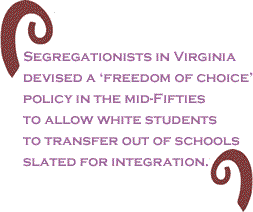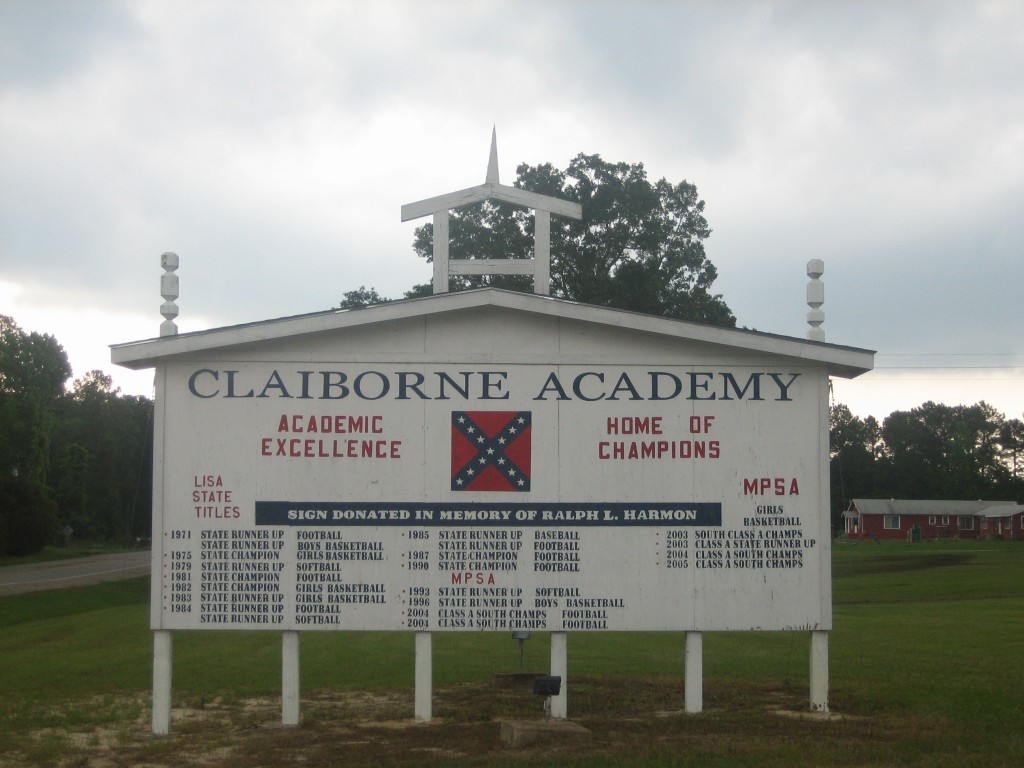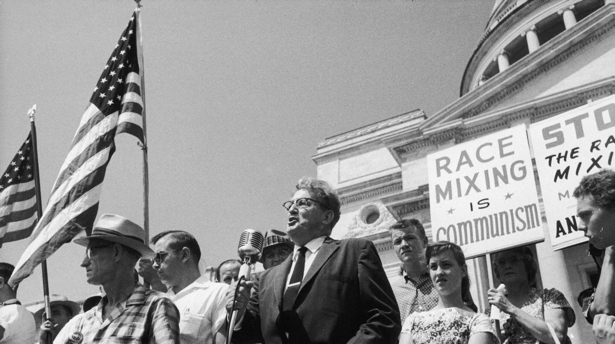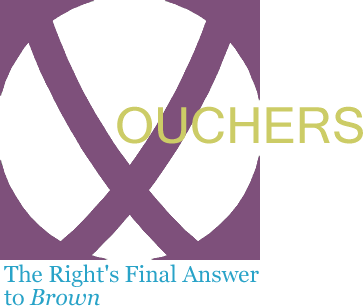
Good Morning POU!
Hope you’re have a wonderful weekend.
We conclude our series with a look at the “Segregation Academy” and the correlation to today’s Voucher movement, the impact of such schools on public education and the opportunities for minority children.
A segregation academy was a private school in the United States that was established in the mid-20th century to enable white parents to avoid having their children in desegregated public schools, which were mandated by the U.S. Supreme Court ruling Brown v. Board of Education (1954). It had determined that segregated schools were unconstitutional. Because Brown did not apply to private schools, the founding of new private academies in the 1950s, 60s, and 70s was a way for whites to practice segregation. While these schools were established chiefly in the southern United States, private schools existed nationwide that catered chiefly to white students, in part also because of economic class.
Since the late 20th century, as social patterns in United States have changed, many of these private schools began to admit minority students; others have ceased operations. Still others, in poor, majority-black regions such as the Mississippi Delta and the Alabama and Georgia Black Belt, continue to operate with few, if any, black students. The latter may be excluded because of economic issues as well as race, being unable to pay the fees.
The first segregation academies were created by white parents in the late 1950s in response to the Brown v. Board of Education (1954), which required public school boards to eliminate segregation “with all deliberate speed.” Because the ruling did not apply to private schools, founding new academies provided parents a way to continue to educate their children separately from blacks. At this time, most adult blacks were still disenfranchised in the South, excluded from politics and oppressed under Jim Crow. Private academies operated outside the scope of the Brown v. Board of Education ruling and could therefore have racial segregation.
Reasons why whites pulled their children out of public schools have been debated: whites insisted that “quality fueled their exodus,” and blacks said “white parents refused to allow their children to be schooled alongside blacks”. Scholars estimate that across the nation, at least half a million white students were withdrawn from public schools between 1964 and 1975 to avoid mandatory desegregation. In the 21st century, Archie Douglas, the headmaster of the Montgomery Academy (reputed to have been a segregation academy) said that he is sure “that those who resented the civil rights movement sought to get away from it, took refuge in the academy.”
Seeking to revoke tax-exemption status for non-profit segregation academies, in 1983 some parents in seven southern states sued the IRS in a class action that said the agency’s guidelines to determine whether a private school was racially discriminatory were insufficient. (If a school discriminated racially, it was not to receive tax-exempt status.) In their suit, Allen v. Wright (1983), the plaintiffs named a number of Southern schools as representative of segregation academies. The parents sued the Internal Revenue Service, contending that IRS guidelines for determining whether a private school was racially discriminatory were insufficient.
The case was decided in 1984 by the U.S. Supreme Court, which ruled that citizens do not have standing to sue a federal government agency based on the influence that the agency’s determinations might have on third parties (such as private schools). The judges noted the parents were in the posture of disappointed observers of the governmental process, that although the complaint asserted that “there are more than 3,500 racially segregated private academies operating in the country having a total enrollment of more than 750,000 children” (J.A. 24), it cited by name only 19 “representative” private schools, and that the parents did not allege that they or their children had applied to, been discouraged from applying to, or been denied admission to any private school or schools.
A direct line runs from the “segregation academies” of the post-Brown South and today’s corporate-invented school vouchers “movement.”
Both talk the same language: a “freedom of choice” double-speak that would preserve and expand racial and economic privilege. In place of Brown, today’s voucher advocates would subsidize the “choices” that somehow become available in an American social marketplace that has historically devalued Blacks. They would achieve this unregulated educational supermarket by liquidating the principle and promise of universal, quality public education.
Just as segregationists shut down the public schools of Prince Edward County, Virginia, in 1959 in favor of private white and Black academies, today’s voucher advocates openly agitate for defunding urban public schools. The very same rightwing forces that sought to neuter Brown at every stage in its 50-year history now push privatization as a remedy for the misery they have wrought in America’s cities. They aim to profit – literally – from their own crimes.
Rewards for racism
“The crusade for vouchers actually has its roots in an effort to continue segregation,” said Cynthia Tucker, editorial page editor of the Atlanta Journal-Constitution, in a July 7, 2002 column. “By the time of Jimmy Carter’s presidency, the parents of segregation academy students were campaigning for tax breaks for private school tuition. They formed the early core of what later became the voucher movement.”

The haste with which southern whites established private schools after 1954 made it impossible to cloak the exodus in euphemisms – this was white flight from physical proximity to Blacks, pure and simple, and the name “segregation academies,” stuck. Whites in the North would react in much the same way when their turn came, opting out of the cities entirely to invest their taxes in quality schools for their own children in the suburbs. Those who remained in places like Boston chose private education over integration. “You saw an immediate drain of white participation from public education, going into parochial and private schools,” said Rev. Graylan Hagler, president of Ministers for Racial, Social, and Economic Justice. “And ever since, they have attempted to redirect public dollars out of public education and into private schools.”
Racists always find a “freedom” to mask their hatreds. Segregationists in Virginia devised a “freedom of choice” policy in the mid-Fifties to allow white students to transfer out of schools slated for integration. When Prince Edward County whites finally exhausted their legal bag of tricks in 1959, they shut the public schools down and set up a foundation to support the education of whites.
The county schools were among the five cases that had been combined under Brown. The late Wilbur Brookover, a Michigan State University sociologist who testified as an expert in Brown, chronicled the county’s response to the decision:
”The White school foundation…moved rapidly to raise money to establish the Prince Edward Academy, which used a variety of facilities beginning in fall 1959. Permanent Academy facilities for both elementary and secondary students were built soon after. Essentially all of the White children in Prince Edward County were enrolled in the Academy in the next few years. Some of the poor Whites in the county were provided scholarships to pay their children’s tuition….
“Although Whites established a private foundation to provide similar opportunities for Black children, many Black county residents and the NAACP refused this on the grounds that it continued essentially the same situation that theBrown decision was supposed to end. Those opposing this effort vocalized their concern by actively working to discourage Black children from signing up for the private schools. In January 1960, the Southside Schools, the name given to the private schools, received an application from one Black student. After that, private school advocates decided to postpone their efforts to educate Black students.”
In many ways the goal of integration as an ideal of school quality has been abandoned. In fact, contemporary school activists have embraced racial imbalance in their push for charter schools. Research finds that charter schools are much more likely than traditional public schools to be racially unbalanced. A 2013 study of North Carolina schools found that 30 percent of traditional public school students attended racially segregated schools, while more than 60% of charter school students attend racially unbalanced schools. These charter schools are the impetus for “school choice” activists to push for vouchers.
Sources: Wikipedia, The Black Commentator and The Atlantic



